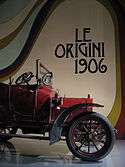Alfa Romeo 156
The Alfa Romeo 156 (Type 932) is a compact executive car produced by the Italian automobile manufacturer Alfa Romeo. It was introduced at the 1997 Frankfurt Motor Show[4] as the replacement for the Alfa Romeo 155. The 156 received a positive reception and in the following year went on to win the 1998 European Car of the Year award.[5] The 156 saloon was discontinued in Europe late in 2005, while the Q4 Crosswagon continued in production until the end of 2007.[6]
| Alfa Romeo 156 | |
|---|---|
.jpg) 2006 Alfa Romeo 156 Sportwagon | |
| Overview | |
| Manufacturer | Alfa Romeo |
| Production | 1997–2007 |
| Assembly |
|
| Designer |
|
| Body and chassis | |
| Class | Compact executive car (D) |
| Body style | |
| Layout | |
| Platform | Type Two rev. 3 |
| Related | |
| Powertrain | |
| Engine |
|
| Transmission | |
| Dimensions | |
| Wheelbase | 2,595 mm (102.2 in) |
| Length | |
| Width |
|
| Height |
|
| Kerb weight | 1,230–1,530 kg (2,712–3,373 lb) |
| Chronology | |
| Predecessor | Alfa Romeo 155 |
| Successor | Alfa Romeo 159 |
Cars were assembled at the Fiat Group factory in Pomigliano d'Arco, Italy and at a General Motors facility in Rayong, Thailand. Production in Thailand began in March 2002 and ran for only a couple of years. The cars produced there were targeted for the Asia-Pacific markets.[7] Between 1997 and 2005, approximately 680,000 units of the 156 were produced.[8]
The 156 was available in saloon, Sportwagon (estate) and Crosswagon (crossover) bodystyles with seven engine configurations; it went through two facelifts, first in 2002 and then in 2003. The Sportwagon advertising campaign was made featuring actress Catherine Zeta-Jones.[9]
In 2007 the 159 became the replacement for the 156. This replacement vehicle went on to also spawn the Brera, the three-door coupé that replaced the Alfa Romeo GTV along with its convertible variant, the new Spider.
Overview
Since the 156's introduction, various four cylinder engine configurations were available and included the Alfa Romeo Twin Spark engine (1.6 L - 120 PS (88 kW), 1.8 L - 144 PS (106 kW) and 2.0 L - 155 PS (114 kW)) 16 valve models with variable valve timing, along with the straight-4 1.9 litre 8-valve 105 PS (77 kW). The range also included a straight-5 2.4 litre 10-valve 136 PS (100 kW) JTD common rail turbodiesel engine. Until January 2002, the range-topping engine was the venerable 2.5 litre 24-valve Busso V6 - now with double overhead camshafts and four-valve heads - rated at 190 PS (140 kW).
Initially the 156 range was available with different options (packs) like a sport pack that included Blitz clothing, Momo leather interior and Recaro seats, it also included 16-inch (410 mm) wheels, lowered suspension and leather-trimmed steering wheel and gear knob. The Lusso pack added with Momo's mahogany steering wheel and gear knob and for Nordic countries, a special winter pack consisting of fog lights, headlight washers, and heated seats was available.[1]
_JTS_Selespeed_station_wagon_(23938785251).jpg)
Starting from 1999 a five-speed Selespeed automated manual transmission was available as an option on the 2.0 litre Twin Spark version and a four-speed automatic Q-System on the 2.5 litre V6 version,[10] the Q-system provided the option of using the car as a normal automatic or being able to shift manually with H-pattern,[3] it has three automatic modes: city, sport and ice.
A significant addition to the 156 range came in 2000 with the introduction of the Sportwagon Station wagon or estate bodystyle, a first attempt at this configuration for the company. The Sportwagon was also available with Boge-Nivomat self-levelling hydropneumatic rear suspension.[11] The Sportwagon was marketed as a lifestyle estate without large carrying capacity.[12] The Sportwagon bodystyle filled a gap in the market that Alfa Romeo had distanced themselves from since the 33 SportWagon of the 1980s.
In 2001 engines were upgraded to comply with the Euro III standards and were rated at 120 PS (88 kW) (1.6 L), 140 PS (103 kW) (1.8 L), 150 PS (110 kW) (2.0 L) and 192 PS (141 kW) (2.5 L).
Design
Designed by Alfa Centro Stile under the guidance of head designer Walter de'Silva the 156s shape was intended to be distinctly Alfa Romeo.[13] Its styling included high, curved flanks, retro styled front door handles, recessed rear door handles, and a deep grille requiring an off-centre licence plate holder. The design featured visually deemphasized rear door handles and accentuated front handles, giving the illusion of a coupé profile. The design was influenced by the Alfa Romeo 1900, Giulietta and Giulia.[14] The 156 achieved a drag coefficient (Cd) of 0.31.[1]
Interior


The original interior uses a scalloped upper dashboard and a simple centre console. The main controls and displays are angled to the driver. The interior design lacks cup holders.
The 156 Sportwagon features fold-down rear seats to increase the luggage area normally covered by a privacy screen.
2002 saw an update to both the interior and exterior of the 156.
Facelifts
2002 facelift (first series)
2002 also saw the arrival of a facelifted interior with different matte-finish surfacing and chrome highlights. This new version featured the 147's dual-zone digital climate controller while the interior climate could also be controlled via an air quality sensor.[15] A different choice of colours were available for the interior, with the option of a two-tone interior very much like that on offer from its European rivals. A wider range of options including xenon lighting, tele-informatics (CONNECT and CONNECT NAV) and a Bose stereo system were available, the stereo system could now also be operated via buttons on the steering wheel. Also, the Selespeed gearbox control system was updated, buttons on the steering wheel were replaced by paddle shifters, as seen on the earlier Alfa Romeo 147. In the center console, the designers added a multifunctional display with trip computer, fault, and service monitor.
The upgrade also included electronic stability control VDC (Vehicle Dynamic Control) with an emergency brake assist device and slip control ASR (Anti Slip Regulation) came as standard. Additionally, an MSR (Motor Schleppmoment Regelung) was added to the car, this device prevents wheel skidding by restoring torque to the engine for example when the gear is shifted down abruptly under conditions of low grip. Passive safety was also made better, all versions got window airbags as standard. The 2.0 L JTS 165 PS (121 kW) engine with gasoline direct injection replaced the 2.0 litre Twin Spark engine, offering more low end torque and more power than the Twin Spark. The diesel engines were also uprated. The only notable difference exterior-wise was body-coloured mirrors and bumper strips which were earlier black.
2003 facelift (second series)
Late 2003 saw the launch of a facelifted 156, with new front and rear fascias designed by Giorgetto Giugiaro.[16] A new top of the line model was added to the line up called TI (Turismo Internazionale) designating a sporty kit, this version was equipped with modified suspension, bigger wheels (215/45 17") and leather-trimmed interior. The GTA models never received the exterior update. Diesel engines underwent a major overhaul which included a new four-valve per cylinder heads and a second stage common rail injection with 1400 bar maximum injection pressure with up to five injections per cycle for lower noise, consumption, and higher performance. They were rated at 140/150 PS (103/110 kW) for straight-4 1.9 litre 16-valve and 175 PS (129 kW) for straight-5 2.4 litre 20-valve.


_JTS_Selespeed_station_wagon_(23913128482).jpg)

Variants
156 GTA
The 156 GTA and 156 Sportwagon GTA were launched at the Frankfurt Motor Show in September 2001. The GTA was named after the Alfa Romeo GTA from the 1960s, the letters GTA meaning Gran Turismo Alleggerita (English: lightened Grand Tourer). Developed alongside the 147 GTA,[17] it was an exclusive high-performance model hand assembled on a dedicated production line separate to the standard 156 models.
1,973 berlinas and 1,678 Sportwagons were built until the GTA production stopped in October 2005, as the V6 engine as unable to meet emissions regulations and due to the 156 being replaced by the 159.[17][18] The GTA was sold in limited numbers, with right-hand drive vehicles holding a premium over left-hand drive vehicles due to their rarity.
The very first GTA was sold via online auction, from 13 to 23 September, the duration of the Frankfurt Motor Show. Winning bid was €48,691.26, which was donated to "Telethon" charity fund.[19]
.jpg)
The 3.2-litre Bussone V6 engine (The big Busso, so-called after legendary Alfa Romeo engineer Giuseppe Busso). This engine is praised universally for its sound and revving capabilities.[20] This was the largest iteration of the engine built by Alfa Romeo. The engine has a 93 mm (3.7 in) bore and a 78 mm (3.1 in) stroke, displacing at 3,179 cc (194.0 cu in). It was rated at 250 PS (184 kW; 247 hp) and 300 N⋅m (221 lbf⋅ft) of torque. Overall, the car weighed 55 kg (121 lb) more than the standard V6 156.[21]
The GTA variants shared a common interior with post-facelift 156 variants. The doors, boot lid and bonnet were also shared. All else was unique to the GTA, with the engine specifically made by Fiat and Maserati Research Centres.[15]
The GTA did not receive the Giugiaro designed facelift introduced on the 156 in 2002, but continued with the acclaimed Walter de Silva design to the very end of production.
The steering was also made faster, only 1.7 turns from lock to lock compared to 2.1 in normal models. The GTA had also larger brakes (Brembo), at front 305 millimetres (12 in) discs and rear 276 millimetres (10.8 in). The front discs were later upgraded to 330 millimetres (13 in) to cope with the performance potential.
156 Sportwagon Q4
| External image | |
|---|---|
In 2004 Sportwagon Q4, an all-wheel drive version of the Sportwagon was launched in some markets. The Q4 (short for Quadrifoglio 4) system used three differentials, the central one being of the Torsen C limited slip type; it added about 150 kg (331 lb) to the vehicle weight. Graziano Trasmissioni, the Turin-based transmission specialist, developed this system.[22] A raised ride height meant the Sportwagon Q4's was 1,458 mm (57.4 in) tall. Other than the ride height, special 5-spoke 17 inch wheels and a "Q4" badge on the tail set the Sportwagon Q4 apart from the front-wheel drive 156 versions. The Sportwagon Q4 was only available on LHD markets, with no RHD models being built or sold. The only available engine was 1.9 M-Jet diesel with 150 PS (110 kW; 148 hp).
156 Crosswagon Q4
The Crosswagon Q4 was launched in 2004 with a crossover look and enhanced off-road capabilities. The Crosswagon's ride height was raised further compared to the Sportwagon Q4, giving the car better approach and departure angles; at 1,497 mm (58.9 in)[23] it was 6.5 cm (2.6 in) taller than a standard 156. Tall-sidewall all-season tyres on 17 inch wheels were standard. The only available engine was 1.9 M-Jet diesel rated at 150 PS (110 kW; 148 hp). The Crosswagon was made to look more like an all-terrain vehicle by unique front and rear bumpers and door sills with steel inserts. After the introduction of the 159 in 2005 the Crosswagon remained in production, and in 2007 it was the last 156 model to be discontinued.
Special versions
| External images | |
|---|---|
Alfa Romeo 156 GTAm
The Alfa Romeo 156 GTAm was shown at the Bologna Motor Show in December 2002. The car was built by Fiat Group's partner N.Technology. The GTA 3,179 cc (3.2 L; 194.0 cu in) engine was bored to 3,548 cc (3.5 L; 216.5 cu in) and power was increased to 300 PS (221 kW).[24] The car had widened wheel arches, 19 inch tyres and was equipped with N.Technology limited slip differential. This car never reached production phase.
Alfa Romeo 156 Sportwagon GTA 3.5 Autodelta
At the 2004 Geneva Motor Show Italian-based tuning firm Autodelta unveiled a 156 Sportwagon prototype equipped with a 3,548 cc (3.5 L; 216.5 cu in) V6 engine that developed 300 PS (221 kW) at 6,800 rpm.[25] The car was fitted with Bilstein adjustable shock absorbers, Eibach springs and Brembo front brakes with a diameter of 330 millimetres (13 in). Weight was reduced using a composite engine bonnet.[26]
Autodelta 156 GTA 3.7 V6
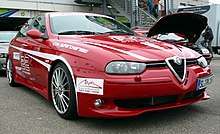
London-based tuning firm Autodelta made two high performance versions based on 156 GTA, in GTA AM version Alfa Romeo V6 engine was bored to 3,750 cc (3.8 L; 228.8 cu in), which was capable of developing 328 PS (241 kW) at 7,300 rpm. With this, the car could attain a top speed of 310 kilometres per hour (193 mph).
The other one GTA AM Super was "upgrade" of the first version, now fitted with Rotrex supercharger and rated at 400 PS (294 kW).[27]
Specifications
Platform and suspension
The 156 uses a platform derived from the Alfa Romeo 155, which in turn was derived from the Fiat Group's "Tipo" platform. However it is sufficiently different from the original "Tipo" one to be seen as a new platform.[28][29] The 156 is a highly developed front-wheel drive car; (the Cross/Sportwagon Q4 offered four-wheel drive in left-hand drive markets) with a double high wishbone front suspension and updated version of MacPherson type rear suspension,[1][30] which consists of a telescopic vertical strut with coaxial spring and two transverse links of different lengths and a longitudinal strut. This structure means that the rear wheels have a tiny passive steering ability.[11] Weight saving materials (mainly aluminium) have been used in several parts both front and rear suspension.
For the 156 GTA, weight saving materials were also used in many other parts like magnesium framed front seats and dashboard frame. The 156 GTA only shared common parts with other 156 variants with respect to the facelift interior, doors, bonnet and boot lid.[31]
Engines
The 156 offered various engines and power output choices during its lifespan, four and six cylinder petrol engines and four and five cylinder diesel engines, all produced at Pratola Serra except the V6 engines, which were produced at Alfa Romeo's Arese plant, with the GTA engines being produced at the Maserati Research Centre.[1][32][33][34][35] The 2.4 JTD diesel was world's first common rail diesel engine in a passenger car.[36]
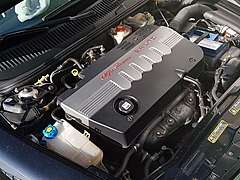

| Engine specifications | |||||||||
|---|---|---|---|---|---|---|---|---|---|
| Model | Layout | Displacement | Valves | Max. power output | Peak torque | 0–100 km/h 0–62 mph |
Top speed | Years | Notes |
| Petrol engines | |||||||||
| 1.6 TS | I4 TS | 1,598 cc (97.5 cu in) | 16 DOHC VVT | 120 PS (88 kW; 118 hp) at 6,300 rpm | 144 N⋅m (106 lb⋅ft) at 4,500 rpm | 10.5 s | 200 km/h (124 mph) | 1997–2006 | |
| 1.8 TS | I4 TS | 1,747 cc (106.6 cu in) | 16 DOHC VVT VLIM | 144 PS (106 kW; 142 hp) at 6,500 rpm | 169 N⋅m (125 lb⋅ft) at 3,500 rpm | 9.3 s | 210 km/h (130 mph) | 1997–2000 | Euro2 |
| 1.8 TS | I4 TS | 1,747 cc (106.6 cu in) | 16 DOHC VVT VLIM | 140 PS (103 kW; 138 hp) at 6,500 rpm | 163 N⋅m (120 lb⋅ft) at 3,900 rpm | 9.4 s | 208 km/h (129 mph) | 2001–2006 | Euro3 |
| 2.0 TS | I4 2BS TS | 1,970 cc (120 cu in) | 16 DOHC VVT VLIM | 155 PS (114 kW; 153 hp) at 6,400 rpm | 187 N⋅m (138 lb⋅ft) at 3,500 rpm | 8.6 s | 216 km/h (134 mph) | 1997–2000 | Euro2 |
| 2.0 TS | I4 2BS TS | 1,970 cc (120 cu in) | 16 DOHC VVT VLIM | 150 PS (110 kW; 148 hp) at 6,300 rpm | 181 N⋅m (133 lb⋅ft) at 3,800 rpm | 8.8 s | 214 km/h (133 mph) | 2001–2002 | Euro3 |
| 2.0 JTS | I4 2BS DI | 1,970 cc (120 cu in) | 16 DOHC VVT VLIM | 165 PS (121 kW; 163 hp) at 6,400 rpm | 206 N⋅m (152 lb⋅ft) at 3,250 rpm | 8.2 s | 220 km/h (137 mph) | 2002–2006 | Facelift |
| 2.5 Q-System | V6 | 2,492 cc (152.1 cu in) | 24 DOHC | 190 PS (140 kW; 187 hp) at 6,300 rpm | 222 N⋅m (164 lb⋅ft) at 5,000 rpm | 8.5 s | 227 km/h (141 mph) | 1997–2000 | Euro2 |
| 2.5 Q-System | V6 | 2,492 cc (152.1 cu in) | 24 DOHC | 192 PS (141 kW; 189 hp) at 6,300 rpm | 218 N⋅m (161 lb⋅ft) at 5,000 rpm | 8.7 s | 227 km/h (141 mph) | 2001–2006 | Euro3 |
| 2.5 V6 | V6 | 2,492 cc (152.1 cu in) | 24 DOHC | 190 PS (140 kW; 187 hp) at 6,300 rpm | 222 N⋅m (164 lb⋅ft) at 5,000 rpm | 7.3 s | 230 km/h (143 mph) | 1997–2000 | Euro2 |
| 2.5 V6 | V6 | 2,492 cc (152.1 cu in) | 24 DOHC | 192 PS (141 kW; 189 hp) at 6,300 rpm | 218 N⋅m (161 lb⋅ft) at 5,000 rpm | 7.5 s | 230 km/h (143 mph) | 2001–2006 | Euro3 |
| 3.2 GTA | V6 | 3,179 cc (194.0 cu in) | 24 DOHC | 250 PS (184 kW; 247 hp) at 6,200 rpm | 300 N⋅m (221 lb⋅ft) at 4,800 rpm | 6.3 s | 250 km/h (155 mph) | 2002–2005 | Euro3 |
| Note: 2.0 TS, 2.0 JTS and GTA Selespeed versions have same performance statistics as manual transmission. | |||||||||
| Diesel engines | |||||||||
| 1.9 JTD | I4 | 1,910 cc (117 cu in) | 8 SOHC | 105 PS (77 kW; 104 hp) at 4,000 rpm | 255 N⋅m (188 lb⋅ft) at 2,000 rpm | 10.4 s | 188 km/h (117 mph) | 1997–2000 | |
| 1.9 JTD | I4 | 1,910 cc (117 cu in) | 8 SOHC | 110 PS (81 kW; 108 hp) at 4,000 rpm | 275 N⋅m (203 lb⋅ft) at 2,000 rpm | 10.3 s | 191 km/h (119 mph) | 2001 | |
| 1.9 JTD | I4 | 1,910 cc (117 cu in) | 8 SOHC | 115 PS (85 kW; 113 hp) at 4,000 rpm | 275 N⋅m (203 lb⋅ft) at 2,000 rpm | 10.3 s | 191 km/h (119 mph) | 2002 | Facelift |
| 1.9 M-Jet | I4 | 1,910 cc (117 cu in) | 16 DOHC | 140 PS (103 kW; 138 hp) at 4,000 rpm | 305 N⋅m (225 lb⋅ft) at 2,000 rpm | 9.3 s | 209 km/h (130 mph) | 2003 | |
| 1.9 M-Jet | I4 | 1,910 cc (117 cu in) | 16 DOHC | 150 PS (110 kW; 148 hp) at 4,000 rpm | 305 N⋅m (225 lb⋅ft) at 2,000 rpm | 9.1 s | 212 km/h (132 mph) | 2003 | (*) |
| 2.4 JTD | I5 | 2,387 cc (145.7 cu in) | 10 SOHC | 136 PS (100 kW; 134 hp) at 4,200 rpm | 310 N⋅m (229 lb⋅ft) at 2,000 rpm | 9.5 s | 203 km/h (126 mph) | 1997–2000 | |
| 2.4 JTD | I5 | 2,387 cc (145.7 cu in) | 10 SOHC | 140 PS (103 kW; 138 hp) at 4,000 rpm | 304 N⋅m (224 lb⋅ft) at 1,800 rpm | 9.4 s | 205 km/h (127 mph) | Oct - 2000 | |
| 2.4 JTD | I5 | 2,387 cc (145.7 cu in) | 10 SOHC | 150 PS (110 kW; 148 hp) at 4,000 rpm | 305 N⋅m (225 lb⋅ft) at 1,800 rpm | 9.4 s | 212 km/h (132 mph) | 2002–2007 | Facelift |
| 2.4 M-Jet | I5 | 2,387 cc (145.7 cu in) | 20 DOHC | 175 PS (129 kW; 173 hp) at 4,000 rpm | 385 N⋅m (284 lb⋅ft) at 2,000 rpm | 8.3 s | 225 km/h (140 mph) | 2003–2006 | Second facelift |
| Note (*): Crosswagon Q4 topspeed is 192 km/h (119 mph) and acceleration 0–100 km/h (62,5 mph) is 10.5 seconds, for Sportwagon Q4 numbers are 200 km/h (124 mph) and 10.2 seconds. | |||||||||
Use in law enforcement
The Alfa 156 sedan and the station wagon were widely used by the Italian and other police and other law enforcement forces. In Italy it was used by Carabinieri, Polizia di Stato, Polizia provinciale, Polizia Penitenziaria and Guardia di Finanza. Subsequently, the 156 was replaced by the more modern Alfa Romeo 159.
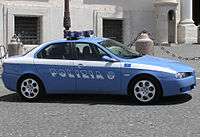 One of the two Alfa 156 III series of Polizia di Stato, equipped with a 2.5 V6 engine.
One of the two Alfa 156 III series of Polizia di Stato, equipped with a 2.5 V6 engine. A 156 Crosswagon of Polizia provinciale.
A 156 Crosswagon of Polizia provinciale.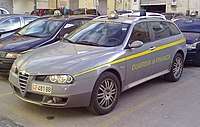 156 2nd series Crosswagon of Guardia di Finanza.
156 2nd series Crosswagon of Guardia di Finanza. The 156 of Corpo de Polizia Civile (Civil Police of San Marino).
The 156 of Corpo de Polizia Civile (Civil Police of San Marino).
Awards
In 1998, an international jury of 56 journalists (40 of whom voted for the 156) representing 21 countries awarded the Alfa 156 the European Car of the Year award;[5] it was described as having a "very refined suspension layout so to offer an impeccable roadholding".[37] The 2.5 V6 engine was awarded with the International Engine of the Year award in 2000.[38] The 156 has won more than 35 awards,[39] including:
- Technical Innovation Award – Common Rail 1998 – (Autocar – Great Britain)
- Best Compact Executive 1998 – (What Car? – Great Britain)
- Best Compact Executive Car 1998 – (Auto Express – Great Britain)
- Die Besten Autos 1998, Paul Pietsch Preis – Innovation prize for Common Rail, (Auto, Motor und Sport – Germany)
- Auto 1 Europa 1998 – (panel of engineers, drivers, and journalists from the eleven European magazines, headed by Auto Bild)
- Auto Trophy 1998 – (Auto Zeitung – Germany)
- Trophee Du Design 1998 – (Automobile Magazine – France)
- European Award for Automotive Design – (Belgium, 1998)
- Car of the Year 1998 in Denmark, Spain, Netherlands, Luxembourg, Germany, Portugal, France, and Croatia
- Car of the Year in South Africa 1999 – (South African Guild of Motoring Journalists)[40]
- Prix de l’Innovation Technique pour le Common Rail 1997 (France)
- L’automobile più bella del mondo ("The most beautiful car in the world") 1997 (Italy)
Motorsport
The 156 competed in various motor racing championships including the World Touring Car Championship, European Touring Car Championship and the British Touring Car Championship. The 156 touring car program was run by Fiat Group's partner N.Technology S.p.A., founded as Nordauto Squadra Corse to compete in Italian Touring Car Championship. In 1994 name was changed to Nordauto Engineering and 2001 to N.Technology.[41]
In 1998 the156 Group N version was offered for sale to the public.[10] The 156 Group N had no carpets, seats or upholstery, but included additional track safety devices.
The following titles have been won by 156 drivers:
- 1998 Italian Super Touring Car Championship - Alfa Romeo 156 D2, Fabrizio Giovanardi
- 1999 Italian Super Touring Car Championship - Alfa Romeo 156 D2, Fabrizio Giovanardi
- 2000 European Super Touring Car Cup Winner - Alfa Romeo 156 D2, Fabrizio Giovanardi
- 2000 South American Super Touring Car Championship, Oscar Larrauri
- 2001 FIA European Touring Car Championship - Alfa Romeo 156 D2, Fabrizio Giovanardi
- 2002 FIA European Touring Car Championship - Alfa Romeo 156 GTA Super 2000, Fabrizio Giovanardi
- 2003 FIA European Touring Car Championship – Alfa Romeo 156 GTA Super 2000, Gabriele Tarquini
.jpg) GTA Racing Team Nordauto Alfa Romeo 156 GTA, Gabriele Tarquini in Donington Park 2003 ETCC
GTA Racing Team Nordauto Alfa Romeo 156 GTA, Gabriele Tarquini in Donington Park 2003 ETCC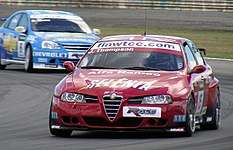 A 156, driven by N.Technology driver James Thompson, during the Curitiba round of the 2007 World Touring Car Championship
A 156, driven by N.Technology driver James Thompson, during the Curitiba round of the 2007 World Touring Car Championship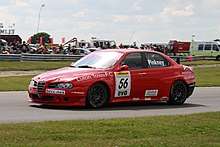 David Pinkney driving a 156 at the Snetterton round of the 2007 British Touring Car Championship
David Pinkney driving a 156 at the Snetterton round of the 2007 British Touring Car Championship The Alfa Romeo straight-4 Twin Spark racing engine used in 156 in the European Touring Car Championship
The Alfa Romeo straight-4 Twin Spark racing engine used in 156 in the European Touring Car Championship
Specifications for touring car versions:
| Model | Displacement | Max. power output |
|---|---|---|
| Alfa Romeo 156 D2 | 1,997 cc (121.9 cu in) | 310 PS (228 kW; 306 hp) at 8,200 rpm |
| Alfa Romeo 156 GTA Super 2000 | 1,998 cc (121.9 cu in) | 260 PS (191 kW; 256 hp) at 8,450 rpm |
| Alfa Romeo 156 Super 2000 | 1,998 cc (121.9 cu in) | 275 PS (202 kW; 271 hp) at 8,450 rpm |
Coloni S1 Alfa Romeo 156

Italian race car constructor Coloni made a one-off racing car prototype for FIA Group-E Formula Libre called the Coloni S1 Alfa Romeo 156, or 156 Maxiturismo.[42] The car is a carbon fibre silhouette racing car on a tubular frame,[43] powered by a 3.0 litre Alfa Romeo V6 engine rated between 380 hp (280 kW) and 500 hp (370 kW). The car has a 6-speed Hewland-Coloni sequential gearbox and weighs around 900 kilograms (2,000 lb). It is capable of attaining speeds of over 310 kilometres per hour (190 mph).[43]
References
- "Alfa 156: Reinvention of the sports saloon". alfaromeopress.com. Archived from the original on 12 August 2014.
- "Automotive Intelligence News". autointell.com. Archived from the original on 10 February 2012.
- "Unique performance automatic gearboxes for the new Alfa Romeo 156". autoweb.com.au. Archived from the original on 28 September 2007. Retrieved 27 January 2008.
- "Press release 01/09/1997". alfaromeopress.com. Archived from the original on 5 November 2013.
- "Rewind to 1998: Alfa Romeo 156". Quicks. Archived from the original on 15 April 2014. Retrieved 21 January 2014.
- "Alfa Romeo Crosswagon Q4". autozine.nl (in Dutch). Archived from the original on 18 February 2012.
- "Equipment boost for 2002 Alfa Romeo 166". autoweb.com.au. Archived from the original on 6 July 2011. Retrieved 8 May 2007.
- "Zeta Sorting sleek sharks from ugly angler fish". telegraph.co.uk. Archived from the original on 14 June 2018. Retrieved 17 June 2018.
- "Catherine Zeta Jones rides at Alfa Romeo". fleshtival.com. Archived from the original on 11 July 2011. Retrieved 14 January 2011.
- "Alfa Romeo history 1990–2000". alfaromeo.com.au. Archived from the original on 19 February 2007. Retrieved 25 April 2007.
- "Alfa Romeo 156 restyling article, page. 5". Archived from the original on 25 February 2012. Retrieved 25 April 2007.
- "2003 Alfa Romeo 156 2.0 JTS Sportwagon review". carenthusiast.com. Archived from the original on 7 February 2012. Retrieved 6 August 2007.
- "Alfa Romeo 156 Women's view". uk.cars.yahoo.com. Archived from the original on 5 June 2011. Retrieved 27 January 2008.
- "History of Alfa Romeo 156 (project 932) (v2.0)". alfa156.net. Archived from the original on 23 July 2011. Retrieved 25 April 2007.
- "New Alfa 156 and Alfa 156 GTA". alfaromeopress.com. Archived from the original on 12 May 2014. Retrieved 5 February 2009.
- "New Alfa 156 and Alfa Sportwagon". alfaromeopress.com. Archived from the original on 6 March 2016. Retrieved 5 February 2009.
- "Alfa Romeo 156 Gta Review | CCFS UK". www.classiccarsforsale.co.uk. Retrieved 6 May 2020.
- "Alfa Romeo 156 GTA (2002–2006) used car review". www.rac.co.uk. Retrieved 6 May 2020.
- "The first Alfa 156 GTA will go to Japan". fiatgroupautomobilespress.com. Archived from the original on 10 November 2014. Retrieved 7 January 2007.
- EVO Magazine August 2011 page 77
- "Alfa Romeo 156 GTA: Unsung Hero | PistonHeads". www.pistonheads.com. Retrieved 6 May 2020.
- "2004 GENEVA AUTO SHOW: Cooked under pressure". autonews.com. 23 February 2004. Retrieved 2 July 2019.
- "Alfa Romeo takes to the Alps in Switzerland with the Alfa 156 Crosswagon". alfa.co.nz. Archived from the original on 7 February 2012. Retrieved 25 April 2007.
- "Alfa Romeo 156 GTAm". mitoalfaromeo.com (in Italian). Archived from the original on 23 July 2011. Retrieved 25 April 2007.
- "Alfa Romeo 156 Sportwagon GTA 3.5 Autodelta". italiaspeed. Archived from the original on 25 February 2012. Retrieved 7 January 2007.
- "Alfa Romeo 156 Sportwagon GTA 3.5 Autodelta". carenthusiast.com. Archived from the original on 26 October 2011. Retrieved 25 April 2009.
- "Autodelta 156 GTA AM". autodelta.co.uk. Archived from the original (DOC) on 3 March 2016. Retrieved 7 January 2007.
- "Tipo's derivatives". fiat-tipo-portugal.com. Archived from the original on 5 March 2012. Retrieved 24 July 2007.
- "Alfa Romeo 156". alfaworkshop.co.uk. Archived from the original on 27 December 2011. Retrieved 24 July 2007.
- "2004 Brochure" (PDF). Retrieved 2 November 2018.
- "Alfa Romeo / 156 / Twin Spark sedan". goauto.com.au. Archived from the original on 10 April 2012. Retrieved 7 January 2007.
- "Technical Specifications". alfisti.ru. Archived from the original on 7 February 2012. Retrieved 7 January 2007.
- "new models: facelifted Alfa Romeo 156 and Sportwagon including GTA versions". italiaspeed.com/newmodels_156gta. Archived from the original on 25 February 2012. Retrieved 7 January 2007.
- "Alfa 156: Technical specifications". fiatgroupautomobilespress.com. Archived from the original on 4 March 2016. Retrieved 7 January 2007.
- "Technical information". alfa156.net. Archived from the original on 23 July 2011. Retrieved 7 January 2007.
- "New Powertrain Technologies Conference". alfa156.net. Archived from the original on 7 February 2012. Retrieved 7 January 2007.
- "Previous winners". caroftheyear.org. Archived from the original on 1 January 2012. Retrieved 7 January 2007.
- "Previous winners". ukipme.com. Archived from the original on 7 January 2012. Retrieved 7 January 2007.
- "Alfa Romeo 156 restyling article, page. 9". ukipme.com. Archived from the original on 25 February 2012. Retrieved 25 April 2007.
- "SA's Car of the Year named". motoring.iafrica.com. Archived from the original on 25 February 2012. Retrieved 12 July 2009.
- "N.Technology background". ntechnology.it. Archived from the original on 16 March 2007. Retrieved 25 April 2007.
- "156 Maxiturismo". alfisti.net. Archived from the original on 12 February 2012.
- "Engineering". colonimotorsport.com (in Italian). Archived from the original on 10 February 2012.
External links
| Wikimedia Commons has media related to Alfa Romeo 156. |
- Alfa Romeo 156 resources (International)
- Alfa Romeo 156 at the Internet Movie Cars Database
